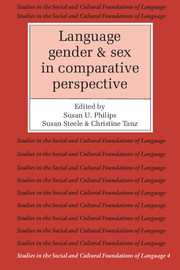Book contents
- Frontmatter
- Contents
- Acknowledgments
- List of contributors
- Introduction: The interaction of social and biological processes in women's and men's speech
- Part I Women's and men's speech in cross-cultural perspective
- Part II Gender differences in the language of children
- Introduction
- 6 Preschool boys' and girls' language use in pretend play
- 7 Sex differences in parent–child interaction
- 8 Children's arguing
- 9 Do different worlds mean different words?: an example from Papua New Guinea
- Part III Sex differences in language and the brain
- References
- Index
8 - Children's arguing
Published online by Cambridge University Press: 05 June 2012
- Frontmatter
- Contents
- Acknowledgments
- List of contributors
- Introduction: The interaction of social and biological processes in women's and men's speech
- Part I Women's and men's speech in cross-cultural perspective
- Part II Gender differences in the language of children
- Introduction
- 6 Preschool boys' and girls' language use in pretend play
- 7 Sex differences in parent–child interaction
- 8 Children's arguing
- 9 Do different worlds mean different words?: an example from Papua New Guinea
- Part III Sex differences in language and the brain
- References
- Index
Summary
Whereas a great deal of research in sociolinguistics has been directed toward the investigation of politeness as an organizing feature of conversation (and, in particular, of women's conversations), far less attention has been given to how people manage opposition, a type of talk that is generally evaluated negatively and viewed as disruptive. The present study will present an ethnographically based description of how girls and boys carry out the activity of arguing. When this activity is examined in detail, it is found that, rather than being disorderly, arguing provides children with a rich arena for the development of proficiency in language, syntax, and social organization. Moreover, in contrast to the prevalent stereotype that female interaction is organized with reference to politeness and a dispreference for dispute (Gilligan 1982:9–10; Lever 1976:482; Piaget 1965:77), we find that girls are not only just as skilled in argumentation as boys but have types of arguments that are both more extended and more complex in their participation structure than those among boys.
In this chapter we first provide some background information on the Maple Street group and fieldwork methods. Then we examine how everyday instances of conflict are conducted in cross-sex situations, paying close attention to the formulation of opposition moves. Finally we turn to a consideration of how more serious confrontations, in which one's reputation is at stake, are managed in girls' and boys' same-sex groups.
- Type
- Chapter
- Information
- Language, Gender, and Sex in Comparative Perspective , pp. 200 - 248Publisher: Cambridge University PressPrint publication year: 1987
- 134
- Cited by

